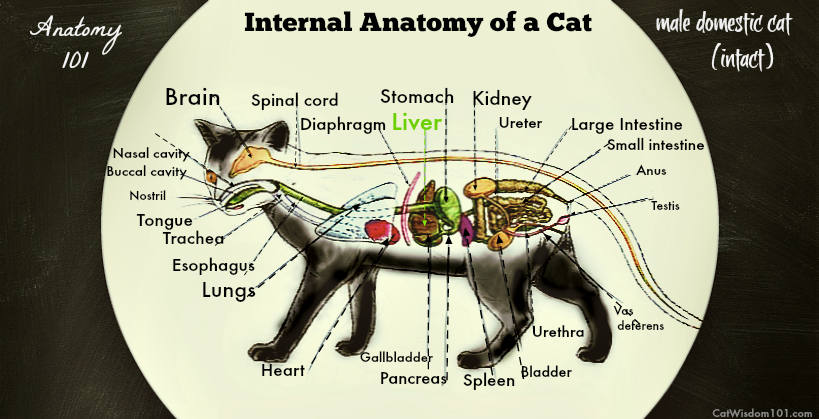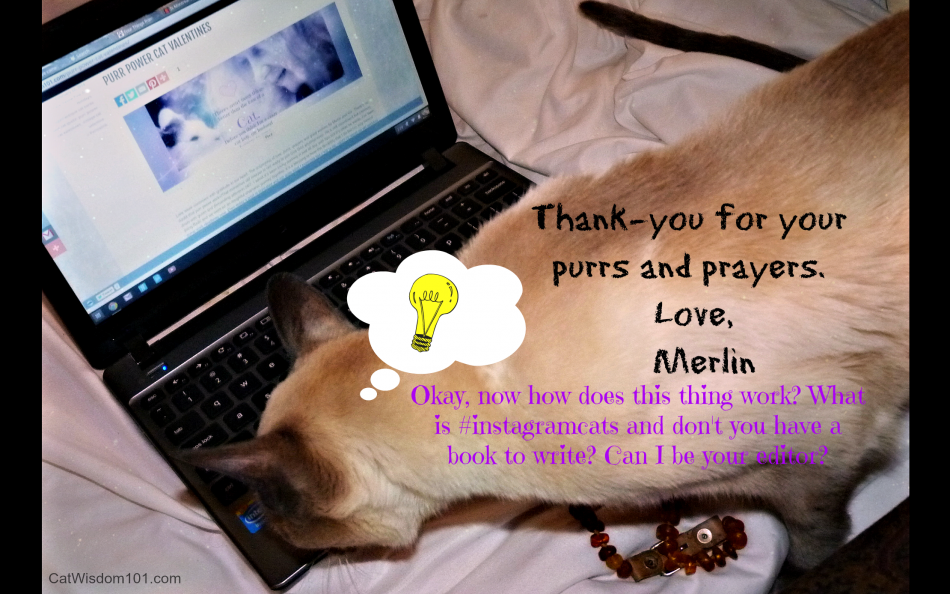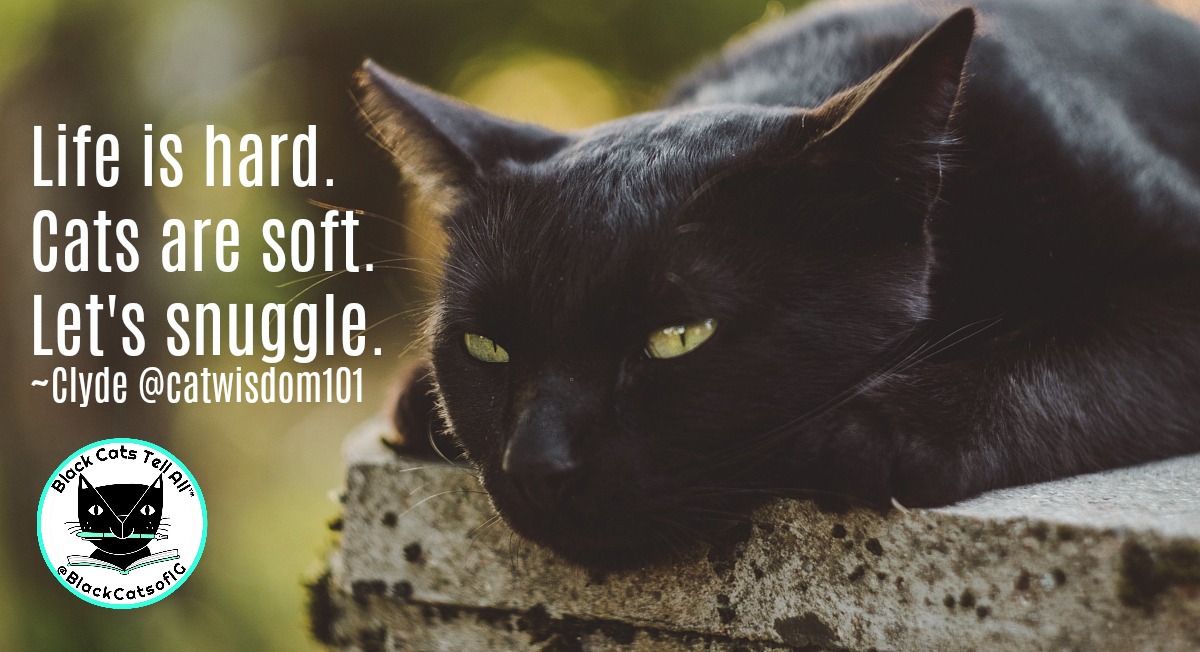Vet 101: Do You Know These Two Common Liver Disorders in Cats?
This week’s Vet 101 is by veterinarian, Dr. Letrisa Miller has a feline-only practice Connecticut Feline Medicine and Surgery in Manchester, Connecticut.
Common Liver Disorders in Cats:
Cholangitis and Cholangiohepatitis
by Letrisa M. Miller, MS, DVM

Liver disease is one of the more common problems seen in middle-age to older cats. It is commonly associated with pancreatitis and inflammatory bowel disease, so it often gets lumped into a diagnosis of what a lot of veterinarians like to call triaditis (three inflammations). Published reports suggest that a few breeds of cat may be more prone to the disease, but in my clinical experience all breeds have been equally represented.
- Male cats are reported to have cholangiohepatitis more than females.
- Cholangitis is the inflammation of the bile system in the gall bladder and bile ducts. It often also includes a certain amount of what is called cholestasis or slowing or stopping of production of bile by the liver.
- Cholangiohepatitis is inflammation of the bile system and the liver and often becomes more life threatening quickly.
- In order to understand these two conditions, some background on how the liver functions and the bile system is helpful.
- The liver is important in metabolizing and excreting many things including energy in several forms, toxic products from digestion, and drugs. The liver is a major workhorse in the body and when it gets sick, the whole body suffers in quick order.
- One of the major ways that the liver rids the body of toxins is through metabolism and excretion in bile and the liver also stores materials such as fat soluble vitamins and energy in the form of glycogen. It is very important in metabolism of fats and produces factors necessary for blood clotting. It also makes one of the major components of blood, a protein called albumin.
Bile pigment, or bilirubin, is what we usually associate with bile. It is a colored material that varies from yellow to green to brown and is made in the liver from hemoglobin break down products. Bilirubin is the substance that causes jaundice in liver disease and it builds up in the body if the liver is unable to make or excrete bile for any reason (cholestasis).
Many other things are present in bile, but it is easier to understand bile by focusing on the pigment compounds (bilirubin). Bile plays a very important role in digestion where it helps to make fats digestible and absorbable and is essential in excreting many compounds such as drugs after metabolism. Stools that don’t have bile in them are usually tan to grey in color.
Bile is also important in the recycling of Vitamin B12 which plays very important roles in most body systems as it is important in digestion, metabolism, nervous system function and production of red blood cells.
Both diseases, cholangitis and cholangiohepatitis, can have symptoms such as inappetence, anorexia, vomiting, drooling, diarrhea, weight loss, clay colored stools, fever, depression, abdominal pain, or jaundice.
- Diagnosis of either of these problems usually requires laboratory tests that might include blood chemistry, complete blood count (CBC), urinalysis, ultrasound and fine needle or surgical biopsy.
- Clinically, cholangitis can be difficult to diagnose if it is not very severe, because laboratory tests may not have large changes from normal unless disease is severe and changes that are seen can be non-specific. A high white blood cell count, elevated total bilirubin, or elevated alanine transferase (ALP) may be seen in blood work and bilirubin may be seen in urine. Often the only sign in mild disease is weight loss.
- Cholangiohepatitis is usually more severe and may have a very sudden onset. Most cases of cholangiohepatitis require an initial hospital stay for treatment.
- Treatment is aimed at reducing symptoms, maintaining nutrition to avoid fatty liver disease, and targeting infection and/or inflammation.
- Treatment usually includes IV fluids and medications for infection and nausea.
- Medication to increase bile production and flow as well as aid in function of the liver is usually given (ursodiol).
- Milk thistle or it’s extract and the anti-oxidant s-adenosyl methionine are also often given to support liver function.
- Antibiotics are usually given for several weeks to up to six months.
- Steroids for inflammation may be given if there is evidence of inflammatory disease, but a biopsy is usually needed to confirm inflammatory disease before this drug is given.
- Complete bile duct blockage is an emergency and requires surgery to re-establish bile flow before there is gall bladder rupture which is fatal in cats.
A feeding tube may need to be placed into the esophagus in order to maintain food intake. Feeding tubes are invaluable in avoiding starvation and the medical complications associated with rapid weight loss in cats. They are also a great way to give oral medications without stressing the patient! Cats tolerate feeding tubes very well and often even seem to enjoy them. They can eat while a feeding tube is in place and it is removed as soon as the cat is eating enough to maintain it’s body weight.
- While the initial care can be intense (and scary) for cats with liver disease, the prognosis for survival and good quality of life is good to excellent. The liver has excellent regenerative qualities and can recover fully. Most cats get well within 2 to 4 weeks, although they may need to stay on some medication for several months and some will need to stay on medication for life.
In most of my patients, there does not appear to be any effect on longevity and the patients live full lives after a brush with liver disease as long as they have frequent well visits that monitor for any return of disease and any underlying problems are treated.





22 Comments
body detoxing
I have a webpage about this same topic and I have to tell you, this is great material. It’s given me several additional ideas for my content that I would never have thought about. Whoever wrote this is doing a first-rate job.
ستاره شناسي
Hi there ,guys how to begin wordpress? many thanks
Janet Guyott
My 17 year old diabetic cat Shadow has been struggling with liver issues for about a year now. His last ultrasound in April of this year showed some mild inflammation and bile build up so we started him on Ursodiol and Enrofloxacin and have kept him on both ever since. He just had new blood work this past Monday and it came back that two of his liver enzymes had improved but one had gone from 223 to 294. Also his red blood cell count has increased to 55. My vet fears that he may have a lymphoma that is hiding and thinks he may only have six months to live. We are keeping him on the Ursodiol but changing his antibotic to Clavamox and also going to try Milk Thistle as well. I would like to get a second opinion but do not know how to do so without insulting my vet who has been very good to all three of my cats. I just want to make sure I am giving Shadow the best treatment and care to preserve his quality of life. We had discussed a bone marrow test but my vet said it would be for information purposes only and would not assist in treatment and we both agreed would be too risky and also cruel to put a 17 year old through. Other than weight loss of 1.4 lbs since April he has been acting fine. He eats great (which scares me now that I read your comment about cats with cancer eating well), he still plays with his younger brothers and climbs up on the couch and windows. Any clarity/advice you could provide would be greatly appreciated as I feel stuck. Thank you so much. Janet
Layla Morgan Wilde
Hi Janet, we are legally unable to dispense veterinary advice to individuals. If you feel you need a second opinion, do so, most vets are not slighted and would want you to have peace of mind. It sounds like you’ve made up your mind about not doing invasive tests. It’s normal to worry and common to second guess. If you’re open to holistic medicine, we find the energetic support of flower essences helpful for both humans and animals Green Hope Farm
Dawn
My lovely bengal boy is going through treatment for cholangiohepatitis at the moment – his symptoms were extremely vague, but the weight loss was one of them and the colour of his pee (bright yellow) which we now know was caused by elevated bilirubin levels. Full bloodwork also showed quite significantly raised ALT levels. Ultrasound performed & although liver, kidneys etc all looked fine, some indication of bile duct obstruction and now taking destolit to hopefully improve flow of bile. Cat doing quite well at the moment and I am being extremely vigilant with regards to his diet – feeding good quality COMPLETE cat food – he does prefer wet. I belive that feeding small, regular feeds beneficial – quite difficult at times when you have a fussy eater. However, after reading comments I am feeling quite positive about long term prognosis.
short url
I’ve been browsing on on the net over 3 hours at present, on the other hand never uncovered any kind of intriguing article similar to yours. It’s beautiful well worth more than enough personally short url. I think, in case most webmasters and writers made very good information because you almost certainly does, the world wide web may be a lot more valuable than ever before.
Church Cat Tom
We read this with great interest since we lost Tom to liver disease. I relive the situation constantly thinking there could have been a way to save him. I know it’s futile now, but the more I know the more I realize I need to know.
Thank you, as always, Layla for your informative posts to help us know our kitties better.
PepiSmartDog
Always happy to see you in our blog hop because you post such important information for all of us to learn and your posts are great.
Thank you for joining our Thankful Thursday Weekly Blog Hop again.
We really appreciate you and your posts and hope to see you this week too. *waves paw* :=o)
Connie Marie
Thank you for thus information. Should a person not feed any fish to cats? What about Salmon? Should you give Milk Thistle supplement as a preventive, and if so, how much?
Layla Morgan Wilde
Connie, too much tuna isn’t good and cats with kidney disease should not eat fish. Otherwise okay.
Brian Frum
We sure didn’t know about any of that. Thanks for sharing sure important information.
Skeeter and Izzy
Thank you for this post. We were not aware of this particular issue in cats. Knowledge is a powerful thing!!!!
Thank you Doc! Thank you Layla!
Luvs
Skeeter and Izzy and the Feral Gang + Twig and Peanut and Romeo >^..^<
The Island Cats
We’ve not heard of these two diseases before. Thanks for the info.
Elizablest Moonrose
One of my kitties died of Liver cancer. He had symptoms like those above and was treated for cholangitis, but then a big old lumpiness showed up and he quickly got very sick and it was decided that rescue efforts were no longer appropriate. I was told liver cancer was extremely rare in cats. What does the vet say about liver cancer in cats?
Dr. Letrisa Miller
I’m so sorry to hear about your kitty!
Liver cancer in cats is uncommon, but I do see it occasionally. The most common in my experience is lymphoma followed by cancer originating from the biliary (bile) system. Cancer origination from liver cells (hepatocytes) is rare.
Liver cancer is difficult to diagnose, but one of the major clinical signs that I have seen is that many cats that have cancer rather than cholangiohepatitis tend to keep eating even when there are a lot of blood abnormalities vs cats that have inflammatory or infectious liver disease tend to be very reluctant to eat.
Thanks for the question!
Dr. Miller
The Swiss Cats
Thank you very much for your post : we never never heard about it ! And it’s good to know that such a scary disease has a good prognosis of survival. Purrs
Angel AbbyGrace
This was very informative and great to know. Thank you for sharing.
Kathryn
Thanks so much for this. Is there a special, recommended diet that ma help prevent this? We were prescribed a urinary diet low in magnesium for Cheddar (his bro Mao also eats the same diet) because Cheddar developed struvite crystals two years ago. He and Mao are doing fine. I do use some Friskies wet food and some dry food that is non prescripton (but no fish products).
Dr. Letrisa Miller
Hi Kathryn,
Avoiding the major allergens (like fish) is the best way that I have found to help prevent inflammatory bowel disease and the complications like liver disorders that go along with it.
It sounds like you are doing a good job!
Dr. Miller
Kathryn
thanks so much!
Fuzzy Tales
Really appreciate this in particular, as we’ve seen a slow upward move of Nicki’s ALT values in blood test results over the years. He’s above normal now, though not enough to concern the vets. (Concerns ME, though!)
Dr. Letrisa Miller
I am always concerned with any abnormal ALT value, particularly if it is slowly increasing. Is there a drug Nicki is taking or illness that might be causing the increase?
Dr. Miller